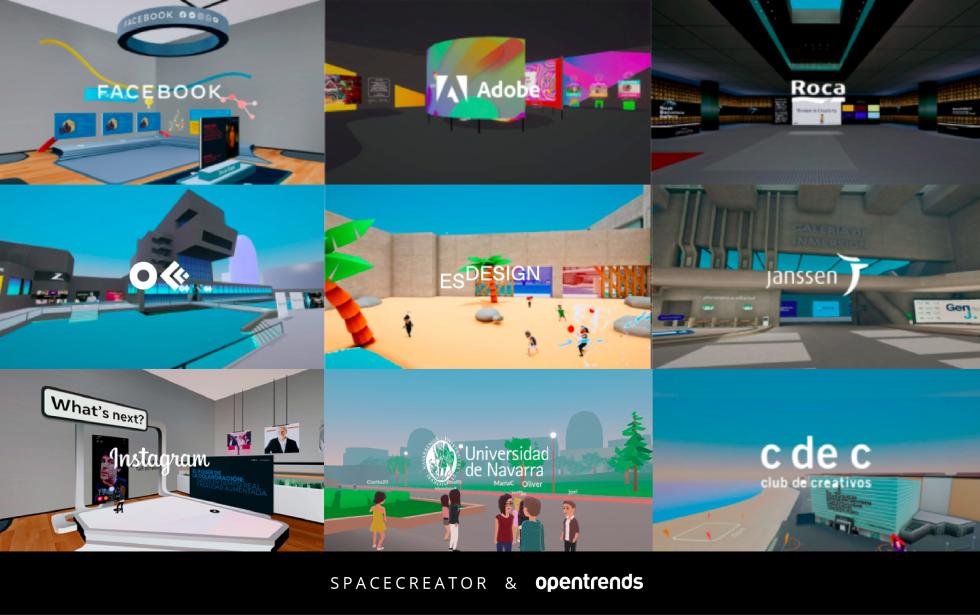
Metaverse in training & events: the new EdTech frontier
For hundreds of years, and until the appearance of distance learning methods and the first eLearning technologies in the 90s, training was given in a classroom and by a teacher.
Web 1.0 brought Learning Management Systems and eLearning content on desktop. Web 2.0 brought social learning, video content and the use of smartphones, so nowadays digital learning is part of the daily lives of all professionals. Next step is Web 3.0, which will necessarily be in 3D, so it is expected that some forms of metaverse will be used as a support to training procedures.
The Metaverse or Metauniverse (from "meta" -beyond- and "universe") is a concept that symbolizes the next generation of the internet and describes an immersive and multisensory experience in the applied use of different devices and technological developments on the Net.
A metaverse is usually made up of multiple three-dimensional virtual spaces.

In a broader sense, the Metaverse may not only refer to virtual worlds, but to the multidimensional experiences of use and application of the Internet as a whole, especially the combined spectrum of Web 2.0, Augmented Reality, Third-Dimensional Technology and Virtual Reality.
Metaverses are environments where humans interact socially and economically as avatars. These interactions take place through logical support in a cyberspace that acts as a metaphor of the real world, but without the physical or economic limitations set there.
There are multiple ways to explain how learning experiences are managed in the Metaverse. A first drawing could be as follows:

At one end, there is the simulation in real environments. Passing through Mixed Reality environments, the other end is reached, that is the simulation in totally virtual environments.
Even if there are many taxonomies, metaverses could also be organized by:
- Functional use (customer dynamization, marketing, sales, games, etc.)
- Open or closed
- Public or private
- Simulation of reality vs. Extended Reality
- The person participates in the experience or is a spectator
In the diagram above, you will find a way to better understand how metaverses are built.
If we take Jon Radoff's layer theory, which is pretty accepted, as a base, training-oriented metaverses should include:
- Experience: learning or sharing knowledge.
- Discovery: community, content care and assessment, stories, etc.
- Creator economy: design tools (there are external ones and those specific to some metaverses), creators of learning assets, content, catalog markets.
- Spatial computing: the most obvious are 3D, XR, AR, AI, etc. engines.
- Decentralization: there are decentralized metaverses that can be used for training, but most of them are private. Knowledge accreditation will probably be done via blockchain.
- Human interface: smartphones, smart glasses, gestures, voice recognition, etc.
- Infrastructure: SG, WIFI 6, 5G, Cloud, GPUS, etc.

Depending on use cases and on the metaverse owner, the content of each layer may change. A game metaverse is not the same as a marketing or training one.
Thus, a metaverse in which there are no transactions or purchase of spaces, where cryptocurrencies are not needed (the blockchain is not relevant), is not the same as one in which users create learning digital assets and handle them.
This idea of the Metaverse is not new. However, the concept of Web 3.0 is gaining strength now because, nowadays, there are a series of changes in technology, users and the environment that are accelerating its adoption.

For example:
- Technology: there is AI, blockchain (it didn’t exist in Second Life, so there was piracy of digital assets), cloud, Oculus (3D glasses) and authoring tools to create content.
- Users: they are used to teleworking, there is an open-space gamer culture and they have all kinds of devices.
- Environment: pandemic, teleworking, cryptocurrencies, Microsoft, Meta and other companies’ investments. There is a general consensus of commitment to Web 3.0.
The most important thing is that people are interested in getting away from the limits of the four physical walls. They want to spend time in a virtual space that is a version or extension of real life. And unlike on-demand content, which is always there when people need it, in the Metaverse, it's not the content, but the users who are available to be part of a real-time event.
Tech products on the market right now range from:
- Basic product: eLearning pills with an integrated AR and VR component. Its contents are linked to the LMS.
- Intermediate simulation scenarios: branching simulation videos in 360, itineraries with geocaching.
- Live virtual office: simulated virtual office that requires Smart glasses.
- Open or private metaverse: use of a virtualized 3D space for a given training practice or simulation, with or without Smart glasses.
We think it is worth paying attention to the following products: Microsoft-Mesh, Meta, Nvidia, Futura Spaces-SEIDOR Opentrends, Metaverse AR Platform and Uptale.
The table below shows some use cases and their impact or benefit for the participants:

Whether you are thinking about building a private metaverse, or you want to create VR/AR content that coexists with your current LMS, we can offer you solutions. Ask us for a demo and a value proposal adjusted to your needs.
In this article [Link artículo 2], you will discover the value proposition that SEIDOR Opentrends makes in the Metaverse.
In addition, in this video you can see some examples of Metaverse technologies for training that are already available, and others that will be soon.










